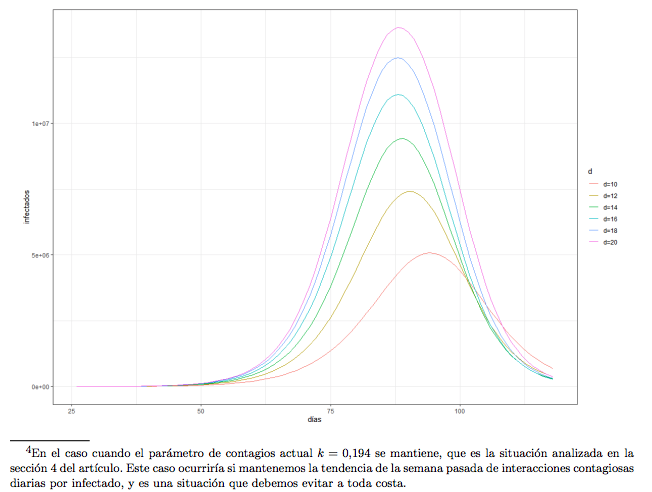“This is an article on the mathematical aspects of the COVID-19 epidemic in Chile, aimed at a general public, not just specialists. We will explain how scientists manage to predict the advance of the epidemic using mathematical models (… )” This is how the article Evolución de las epidemias: la matemática de aislarse(evolution of epidemics: the mathematics of isolating) the PhD in Sciences of Social Complexity, Jorge Castillo, carried out together with the PhD in Mathematics, Héctor Pastén, who assures that “it explains in a very colloquial way how an epidemic grows over time, from the simplest, to a slightly more satisfied model, which we call “simplified SIR”, which models the amount of Susceptibles, Retired and Infected, without the need for the use of differential equations”.
 Since the first case of COVID-19 detected in our country on March 3, the (practically) exponential increase that has been evidenced to date is alarming. The number of infected people exceeds 4,000 to date and it is in this scenario that researchers Castillo and Pastén seek to “raise awareness of the importance of isolation as a measure to slow the growth of COVID-19 in Chile, and to provide educational tools on how scientists make projections on this issue.
Since the first case of COVID-19 detected in our country on March 3, the (practically) exponential increase that has been evidenced to date is alarming. The number of infected people exceeds 4,000 to date and it is in this scenario that researchers Castillo and Pastén seek to “raise awareness of the importance of isolation as a measure to slow the growth of COVID-19 in Chile, and to provide educational tools on how scientists make projections on this issue.
Thus, using a mathematical model (*) in a close and accessible language, the scientists try to predict the advance of an epidemic that, in this case, is the COVID-19. The model chosen for this study is the exponential model: in a given period of time, the number of people infected is multiplied by a fixed constant. Although it is of a predictive nature, Castillo assures that “well-designed mathematical models that take into account their shortcomings when analyzing a prediction, are a valuable tool in decision making”.
Breakdown
Section 1 contains “some” mathematics (“very simple!” in the words of the scientists  themselves), and reading it “is an exercise that for responsibility I should do”. The simplest method of projecting the advance of the epidemic is presented with some projections of what could come for Chile in April.
themselves), and reading it “is an exercise that for responsibility I should do”. The simplest method of projecting the advance of the epidemic is presented with some projections of what could come for Chile in April.
Section 2 contains a more refined version of the elemental analysis in Section 1. Evidence indicates that the rate of infection is currently close to one new case per day for every five infections.
Section 3 presents the CRS model and a simplified version of it. This model for predicting the behavior of epidemics is more realistic and, therefore, gives more reliable predictions in a longer term than the exponential model.
Section 4 uses real data in the simplified SIR model to predict how the COVID-19 will evolve in Chile if we continue at the same rate as before. At this rate, the prediction is a first peak of the disease between late May and early June. The number of cases would get out of control much earlier. In addition, it is explained why models such as SIR have exponential growth in initial stages.
Section 5 examines the projections if the frequency of infections is lowered with a drastic isolation strategy. This implies immediate action: the situation is getting critically worse every day because, at this early stage of the epidemic, the exponential growth model is still valid.
About the authors
Jorge Castillo Sepúlveda, is a mathematical civil engineer from the Universidad de Concepción and a Doctor of Science in Social Complexity (2019) from the Universidad del Desarrollo. He currently works as a data scientist at Z Data Lab, where he leads the areas of price intelligence and trade intelligence, and is a researcher at the Universidad del Desarrollo, where he works on projects associated with data processing and postgraduate teaching.
Héctor Pastén Vásquez is a mathematician from the Pontificia Universidad Católica de Chile. He holds a PhD in Mathematics from the Universidad de Concepción and a PhD in Mathematics from Queen’s University (2014). Previously, he was a researcher at Harvard University (2014- 2018) and at the Institute for Advanced Study at Princeton (2015-2016). He is the recipient of the Governor General of Canada’s Gold Medal for Academic Merit (2014) and the Mathematical Council of the Americas’ MCA award (2017) among other international awards.
(*) A mathematical model is a way of using mathematics to try to predict the future from known data
